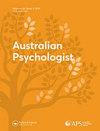A national study of the psychological theories and therapies covered within clinical psychology training programs in Australia
IF 2
4区 心理学
Q2 PSYCHOLOGY, MULTIDISCIPLINARY
引用次数: 1
Abstract
ABSTRACT Objective Recent advancements in the field of psychotherapy have included a diversification in Cognitive Behaviour Therapies (CBTs), often referred to as the “third wave”, yet relatively little is known about their coverage in Australian postgraduate clinical psychology training. Data were gathered to study the relationships between training program theoretical orientation, therapies covered, and factors determining the coverage of therapies. Method Responses to a semi-structured interview of 28 Directors of Clinical Training (DCT) or equivalent of Australian Psychology Accreditation Council (APAC) approved clinical psychology training programs (representing 72% of all accredited programs) were examined. Results Behaviour and cognitive theories were identified as dominant in programs. Coverage of Beck’s CBT was not correlated with other CBTs, and the number of therapies covered did not distinguish integrative (64.3%) from non-integrative programs. In an examination of the factors guiding the adoption of insight orientated therapies (i.e., Cognitive Analytic Therapy, Interpersonal Psychotherapy, Humanistic Therapy, Psychoanalytic Therapy, Process Experiential/Emotion-Focused Therapy, Gestalt Therapy, and Existential Therapy), the focus of clinical research, and student interest emerged as significant predictors (β = −.16, SE =.06, p < .05, 95% Boot CI [−.27, −.03]). Conclusions Beck’s CBT, and its undergirding theories emerged as dominant and was not associated with coverage of more recent CBTs, suggesting that there is opportunity to diversify therapies covered considering their evidence base. KEY POINTS What is already known about this topic: Cognitive Behaviour Therapy (CBT) has evolved and now includes therapies focused on acceptance, dialectical thinking, and mindfulness. Australian clinical psychologists predominantly self-identify a CBT theoretical orientation. Previous surveys of clinical training programs indicate a primary focus on traditional CBT. What this topic adds: Data on the extent to which diverse theories are included in Australian clinical psychology programs. Data on the extent to which various therapies, including third wave CBTs are included in Australian clinical psychology programs. Data on the factors guiding the adoption of therapies in Australian clinical psychology programs.澳大利亚临床心理学培训项目涵盖的心理学理论和疗法的全国性研究
摘要目的心理治疗领域的最新进展包括认知行为疗法(CBT)的多样化,通常被称为“第三波”,但对其在澳大利亚研究生临床心理学培训中的覆盖范围知之甚少。收集数据以研究训练计划理论方向、所涵盖的疗法和决定疗法覆盖范围的因素之间的关系。方法对28名临床培训总监(DCT)或澳大利亚心理学认证委员会(APAC)批准的临床心理学培训项目(占所有认证项目的72%)的同等机构进行半结构化访谈。结果行为和认知理论在项目中占主导地位。Beck's CBT的覆盖率与其他CBT无关,覆盖的治疗数量也没有区分综合性(64.3%)和非综合性项目。在对指导采用以洞察力为导向的疗法(即认知分析疗法、人际心理疗法、人本主义疗法、心理分析疗法、过程体验/情绪聚焦疗法、格式塔疗法和存在主义疗法)的因素进行检查时,临床研究的重点和学生兴趣成为重要的预测因素(β = −.16,SE=.06,p < .05,95%Boot CI[-.27,−.03])。结论Beck的CBT及其基础理论占主导地位,与最近的CBT的报道无关,这表明考虑到其证据基础,有机会使所涵盖的疗法多样化。关键点关于这个话题已经知道的:认知行为疗法(CBT)已经发展,现在包括专注于接受、辩证思维和正念的疗法。澳大利亚临床心理学家主要自我认同CBT理论取向。先前对临床培训项目的调查表明,主要关注传统CBT。本主题补充:澳大利亚临床心理学项目中包含各种理论的程度数据。澳大利亚临床心理学项目中包括第三波CBT在内的各种疗法的程度数据。澳大利亚临床心理学项目中指导采用疗法的因素数据。
本文章由计算机程序翻译,如有差异,请以英文原文为准。
求助全文
约1分钟内获得全文
求助全文
来源期刊

Australian Psychologist
PSYCHOLOGY, MULTIDISCIPLINARY-
CiteScore
3.70
自引率
5.30%
发文量
32
期刊介绍:
The Australian Psychologist is the official applied practice and public policy journal of the Australian Psychological Society. As such, the journal solicits articles covering current issues in psychology, the science and practice of psychology, and psychology"s contribution to public policy, with particular emphasis on the Australian context. Periodically, Australian Psychological Society documents, including but not limited to, position papers, reports of the Society, ethics information, surveys of the membership, announcements, and selected award addresses may appear in the journal.
 求助内容:
求助内容: 应助结果提醒方式:
应助结果提醒方式:


